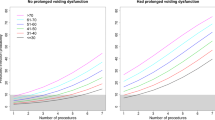Abstract
Introduction and hypothesis
Recurrent urinary tract infections (rUTIs) affect up to 44% of women; evidenced-based guidelines regarding the contributory role of a pelvic examination in these women are lacking. We hypothesize that routine pelvic examination has a limited role in evaluation and management of women with rUTI when appropriate symptoms-based screening is performed and normal post-void residual volume (PVR) is confirmed.
Methods
We performed a retrospective chart review of women ages 18–85 years presenting to Wake Forest Pelvic Health Center with two culture-proven UTIs in 6 months or three UTIs in 12 months with a documented pelvic examination. Pregnant women were excluded. Data extraction included demographics, medical history, screening assessment of vaginal bulge symptoms, urine culture results, imaging, physical/pelvic examination findings, PVR, treatment recommendations and outcomes within 1 year of initial assessment. Descriptive statistics and Fisher’s exact test were performed.
Results
Of 160 charts screened, 91 met the inclusion criteria. Nineteen (21%) had symptoms of vaginal bulge, and 14 (17%) had PVR > 100 ml. Pelvic examination provided new/contributory information in eight (8.8%) of women. The negative predictive value of absence of bulge symptoms and normal PVR was 89%. Within 1 year, 41 (46%) reported symptom resolution with rUTI treatment with no difference between those with or without a contributory pelvic examination (p value = 0.64).
Conclusions
In women with rUTI who report absence of vaginal bulge symptoms and have a PVR < 100 ml, a pelvic examination provides contributory information in < 10% of women and did not change treatment outcomes.
Similar content being viewed by others
References
Bergamin PA, Kiosoglous AJ. Non-surgical management of recurrent urinary tract infections in women. Transl Androl Urol. 2017;6(S2):S142–52.
Foxman B. Epidemiology of urinary tract infections: incidence, morbidity, and economic costs. Dis Mon. 2003;49(2):53–70.
Yamamoto S, Tsukamoto T, Terai A, Kurazono H, Takeda Y, Yoshia O. Genetic evidence supporting the fecal-perineal-urethral hypothesis in cystitis caused by Escherichia Coli. J Urol. 1997;157:1127–9.
Dason S, Dason JT, Kapoor A. Guidelines for the diagnosis and management of recurrent urinary tract infection in women. Can Urol Assoc J. 2011;5(5):316–22.
Aydin A, Ahmed Z, Zaman I, Khan MS, Dasgupta P. Recurrent urinary tract infections in women. Obstet Gynecol Surv. 2015;70(10):621–2.
Hooton TM. Recurrent urinary tract infection in women. Int J Antimicrob Agents. 2001;17(4):259–68.
Scholes D, Hooton TM, Roberts PL, Stapleton AE, Gupta K, Stamm WE. Risk factors for recurrent urinary tract infection in young women. J Infect Dis. 2000;182(4):1177–82.
Car J, Sheikh A. Recurrent urinary tract infection in women. BMJ. 2003;327(7425):1204.
Brubaker L, Carberry C, Nardos R, Carter-Brooks C, Lowder JL. American Urogynecologic Society best-practice statement: recurrent urinary tract infection in adult women. Female Pelvic Med Reconstr Surg. 2018;24(5):321–35.
Recurrent Uncomplicated Urinary Tract Infections in Women: AUA/CUA/SUFU Guideline (2019) – American Urological Assosciation. 2019 [cited Oct 2019]. Available from: https://www.auanet.org/guidelines/recurrent-uti.
Kodner CM, Thomas Gupton EK. Recurrent urinary tract infections in women: diagnosis and management. American family physician. Am Fam Physician. 2010;82(6):638–43.
Anger JT, Litwin MS, Wang Q, Pashos C, Rodriguez L. Complications of sling surgery among female medicare beneficiaries. Obstet Gynecol. 2007;109(3):707–14.
Hammet J, Lukman R, Oakes M, Whitcomb E. Recurrent urinary tract infection after mid urethral sling. Female Pelvic Med Reconstr Surg. 2016;22(6):438–41.
Nygaard I, Brubaker L, Chai T, Markland A, Menefee S, Sirls L, et al. Risk factors for urinary tract infection following incontinence surgery. Int Urogynecol J. 2011;22(10):1255–65.
Committee Opinion No. 694 Summary. Management of mesh and graft complications in gynecologic surgery. Female Pelvic Med Reconstr Surg. 2017;23(3):171–6.
Bonkat G, Pickard R, Bartoletti R, Cai T, Bruyere F, Geerlings SE et al. EAU Guidelines: urological infections. [Accessed 18 August 2019]. Available at https://uroweb.org/wp-content/uploads/EAU-Guidelines-on-Urological-Infections-2018-large-text.pdf.
Lawrentschuk N, Ooi J, Pang A, Naidu K, Bolton D. Cystoscopy in women with recurrent urinary tract infection. Int J Urol. 2006;13(4):350–3.
Toz E, Kurt S, Sahin C, Canda MT. Frequency of recurrent urinary tract infections in patients with pelvic organ prolapse. Res Rep Urol. 2015;7:9–12.
O’Grady F, Cattell WR. Kinetics of urinary tract infection. Br J Urol. 1966;38(2):149–55.
Gehrich A, Stany MP, Fischer JR, Buller J, Zahn CM. Establishing a mean postvoid residual volume in asymptomatic perimenopausal and postmenopausal women. Obstet Gynecol. 2007;110(4):827–32.
Taylor DL, Sierra T, Duenas-Garcia OF, Kim Y, Leung K, Hall C, et al. Accuracy of bladder scanner for the assessment of postvoid residual volumes in women with pelvic organ prolapse. Female Pelvic Med Reconstr Surg. 2018;1.
Theisen JF, Deveneau NE, Agrawal A, Kinman C, Gaskins J, Meriwether K, et al. The accuracy of portable ultrasound bladder scanner measurements of postvoid residual volume in women with pelvic organ prolapse. Female Pelvic Med Reconstr Surg. 2019;25(5):388–91.
Santoni N, Ng A, Skews R, Aboumarzouk O. Recurrent urinary tract infections in women what is evidence for investigating with flexible cystoscopy, imaging, and urodynamics? Urol Int. 2018;101(4):373–81.
Raz R, Stamm WE. A controlled trial of intravaginal estriol in postmenopausal women with recurrent urinary tract infections. N Engl J Med. 1993;329(11):753–6.
Barber MD, Neubauer NL, Klein-Olarte V. Can we screen for pelvic organ prolapse without a physical examination in epidemiologic studies? Am J Obstet Gynecol. 2006;195(4):942–8.
Author information
Authors and Affiliations
Contributions
O Hostetter: Project development, data collection, manuscript writing and editing.
K Hemal: Project development, data collection, data analysis.
K Hines: Data collection, manuscript editing.
C Matthews: Protocol and project development, data analysis, manuscript writing and editing.
Corresponding author
Ethics declarations
Conflicts of interest
Dr. Matthews serves as an expert witness for Johnson& Johnson and has received grant support and consultant fees from Boston Scientific.
Hostetter O, MD, Hemal K, BS, and Hines K, MD, have no conflicts of interest to report.
Additional information
Publisher’s note
Springer Nature remains neutral with regard to jurisdictional claims in published maps and institutional affiliations.
Rights and permissions
About this article
Cite this article
Hostetter, O., Hemal, K., Hines, K.N. et al. Is a pelvic examination contributory in the initial evaluation of women with recurrent urinary tract infections?. Int Urogynecol J 31, 1209–1214 (2020). https://doi.org/10.1007/s00192-019-04198-z
Received:
Accepted:
Published:
Issue Date:
DOI: https://doi.org/10.1007/s00192-019-04198-z




